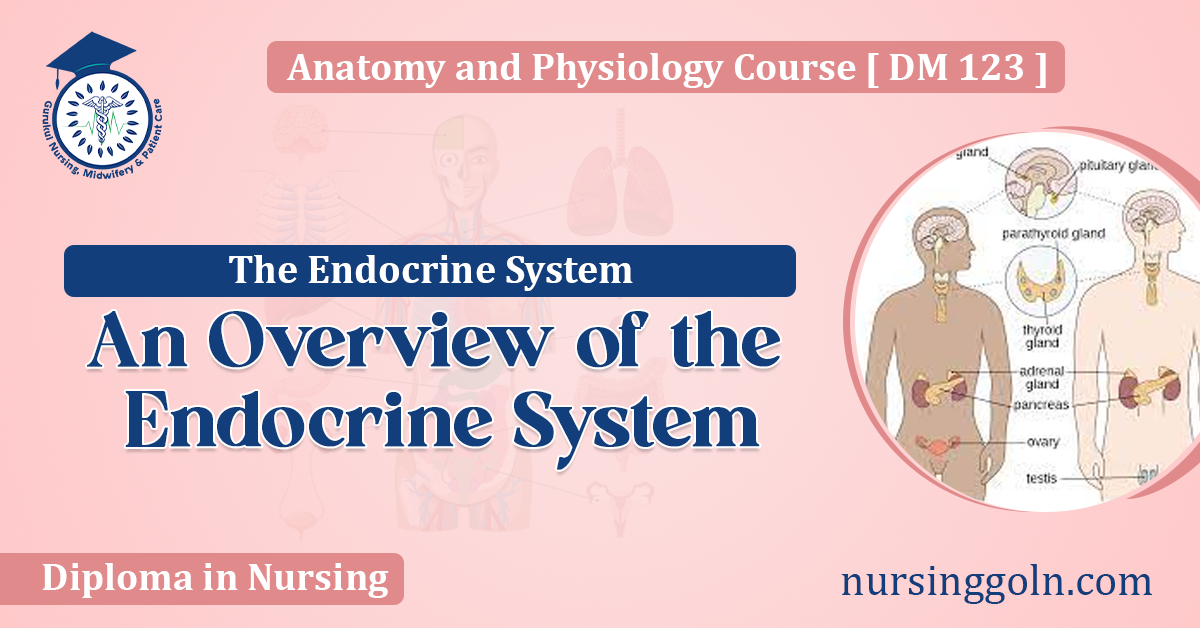Today our topic of discussion is ” An Overview of the Endocrine System “. The endocrine system, a marvel of intricate biochemistry and physiology, operates silently and efficiently, governing a myriad of bodily processes. Unlike the nervous system, which transmits rapid electrical impulses, the endocrine system conveys its messages using chemical agents known as hormones. This article provides a detailed exploration of this system, shedding light on its components, mechanisms, and vital role in maintaining bodily equilibrium.

An Overview of the Endocrine System: The Endocrine System
1. Introduction: A Symphony of Hormones
Beneath the skin’s surface, there’s a continuous, nuanced exchange of chemical messages that keep the body’s diverse functions in harmony. This chemical conversation is orchestrated by the endocrine system, a network of glands that release hormones directly into the bloodstream.
2. Major Components of the Endocrine System
The endocrine system is comprised of several glands, each responsible for producing specific hormones:
2.1 Pituitary Gland
Nestled at the brain’s base, this pea-sized gland is often termed the “master gland.” It secretes a variety of hormones that regulate other endocrine glands, growth, blood pressure, and several vital functions.
2.2 Thyroid and Parathyroid Glands
Located in the neck, the thyroid gland regulates metabolism, energy, and growth. The parathyroid glands, which sit on the thyroid’s posterior surface, play a pivotal role in calcium regulation.
2.3 Adrenal Glands
Situated atop each kidney, the adrenal glands produce hormones such as cortisol (involved in stress responses) and aldosterone (regulates salt and water balance).
2.4 Pancreas
This dual-function organ, located behind the stomach, has endocrine cells called islets that produce insulin and glucagon, vital for blood sugar regulation.
2.5 Gonads
These reproductive glands (testes in males, and ovaries in females) produce sex hormones responsible for sexual development, reproduction, and certain secondary sexual characteristics.

3. Hormones: The Chemical Messengers
Hormones are biochemical substances that convey messages from one cell or organ to another. They regulate a wide array of processes, from growth to metabolism.
3.1 Hormone Production and Release
Endocrine glands synthesize hormones from amino acids or cholesterol. Hormone release can be triggered by various stimuli, including other hormones, neural inputs, or changes in the internal environment.
3.2 Mechanism of Action
Hormones can be categorized into steroid (lipid-soluble) and non-steroid (water-soluble). While steroid hormones enter the cell and act on the DNA directly, non-steroid hormones typically act through second messenger systems.
4. Feedback Mechanisms: Maintaining Balance
The endocrine system relies on feedback loops to maintain balance. These loops ensure that once a particular function is accomplished, the initiating hormone stops being produced.
4.1 Negative Feedback
Most endocrine pathways use negative feedback. For instance, when blood sugar rises, insulin is released. As blood sugar levels drop in response, insulin secretion decreases.
4.2 Positive Feedback
Less common, positive feedback amplifies responses. A classic example is the surge of luteinizing hormone during the menstrual cycle, which results in ovulation.
5. The Endocrine System in Action: Everyday Processes
- Metabolism and Growth: Thyroid hormones regulate metabolic rate, while the pituitary’s growth hormone influences cell growth and division.
- Blood Sugar Regulation: The pancreas’s insulin and glucagon play pivotal roles in maintaining glucose homeostasis.
- Stress Response: The adrenal glands produce cortisol, helping the body respond to stress.
- Reproduction: Hormones from the pituitary and gonads govern the menstrual cycle, sperm production, and pregnancy.
6. Dysfunctions and Disorders
Any imbalance in this finely tuned system can lead to disorders:
- Hypothyroidism: Low thyroid hormone production results in fatigue, weight gain, and cold intolerance.
- Diabetes Mellitus: Insufficient insulin production or action leads to high blood sugar levels.
- Cushing’s Syndrome: Overproduction of cortisol results in weight gain, thinning skin, and fatigue.

7. Conclusion: The Subtle Maestro of the Body
In the grand concert of bodily functions, the endocrine system is a subtle maestro, weaving a complex tapestry of hormonal cues to maintain harmony. Its nuanced orchestrations, though often unnoticed, are paramount to our well-being. As research progresses, our understanding of this wondrous system continues to expand, offering insights into the chemical symphony that is the foundation of life.
Read more:
